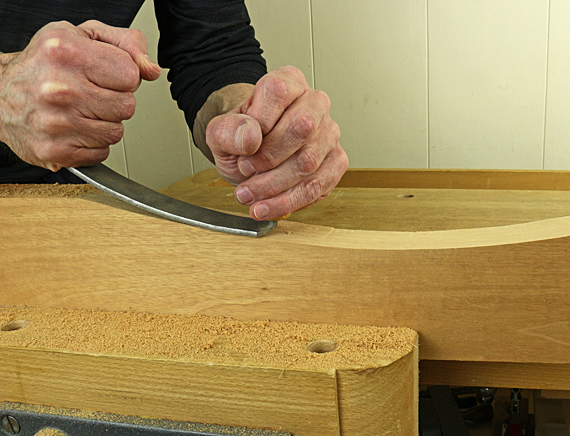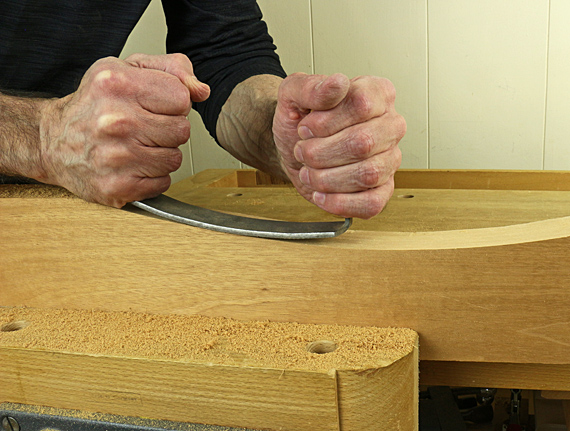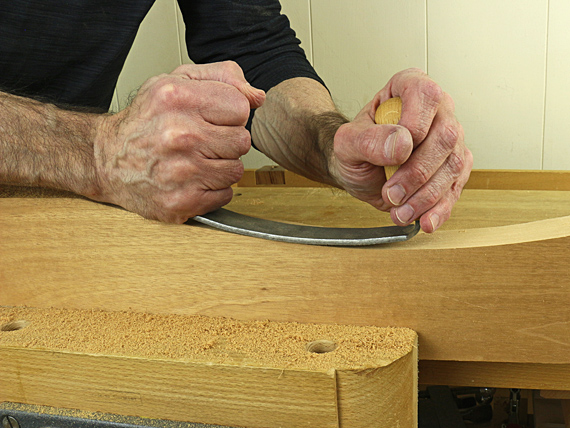
This rasp is unique: the toothed surface is flat across its width with a convex curve along its length, and handled at both ends.
Grasp the handles intuitively – from the sides or over the top – and bring teeth near the leading end into contact with the wood (top photo), then ease the trailing part of the rasp onto the wood (photos below), using a pull or push stroke. Let the sharp teeth do the work; don’t force them into the wood. As you move along the desired curve, you’ll subtly feel more resistance over bumps, less over hollows.

This does not work like a compass plane or spokeshave because they have only one contact point that cuts. The rasp cuts all along its length, encouraging a sweeping motion.

Curves are generally best worked in the downhill direction so as to work with the grain, but this can vary. I readily switch from a pull stroke to a push stroke as I work, gently tipping the rasp toward or away from me as needed. This tool encourages working instinctively.
The constant radius of curvature of the rasp makes all of this easy and intuitive. You can use any part of the rasp, changing from push to pull, and always know the curve you are presenting to the wood is constant. (Of course, this does not mean the rasp is restricted to working on curves of constant radius.) In my early designs for this tool, I found I could not work as fluidly with a variable radius.
The stiffness of the rasp, the tang fit of the handles, and the smooth-cutting sharp teeth, magnificently crafted by Noël Liogier and his team, work together to provide excellent feedback to your hands as the curve takes shape under the tool. You can feel the curve becoming true even before you stop to look at it.
I think you will be delighted with the performance of this rasp. Liogier sells it for €58, about $66, which is a bargain considering its durability, utility, and the incredible workmanship they put into it.


Thanks for the pointers, I am patiently waiting for my rasp to arrive.
Hi Rob,
I finally tried the RP rasp and I am extremely happy with it. I am making a couple of kayak paddles right now and it has the perfect radius for the concave side of the curved paddle blades. I was able to perfectly even out the surface very quickly of all the ridges left by the bandsaw. It was also very useful at blending in the shaft of the paddle where it meets the blade. The paddle blade is a lamination of soft and hard woods, and it works well on both but better on the hardwood (maple and mahogany). For the soft wood (western red cedar), I just have to reduce the pressure I apply on the rasp otherwise being such a soft wood it digs in too much. The handles feel comfortable and I like that the rasp is symmetric and that I can quickly change from a pushing stroke to a pulling stroke. I was also surprised at how nice and smooth of a finish it leaves on the wood.
The only negative thing I found, is that if my hand slipped down the handle closest to my body when I am pushing on the rasp, it would get poked by the very sharp edges of the rasp blade where the tang bends. I rounded over those four sharp corners with a file, and it fixed it. I would send you a picture, but I do not know how to do that in a blog? Perhaps Liogier could round over the sharp edges in the future?
Thank you for designing the tool! I will used it often I am sure.
Thanks so much for the feedback, Pascal. I’m delighted to hear that the rasp is working well for you. I’m particularly happy to hear that the reversibility permitted by the constant radius of the curve is an asset. I went back and forth on that feature as I was designing it, and my own experience, and now yours, have convinced me it was the right choice over a variable curve.
Regarding the harsh corners, yes, I know what you mean, but they’re easy enough to soften with a diamond file, and I suppose it’s one less manufacturing step.
Rob